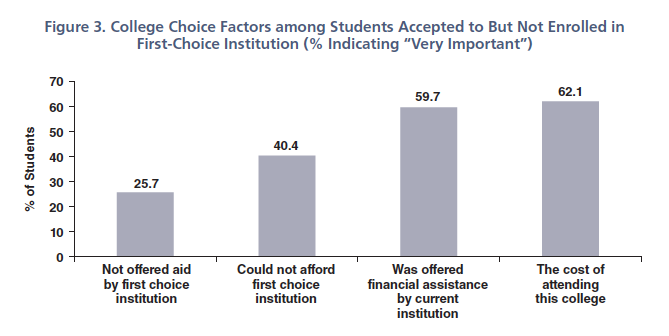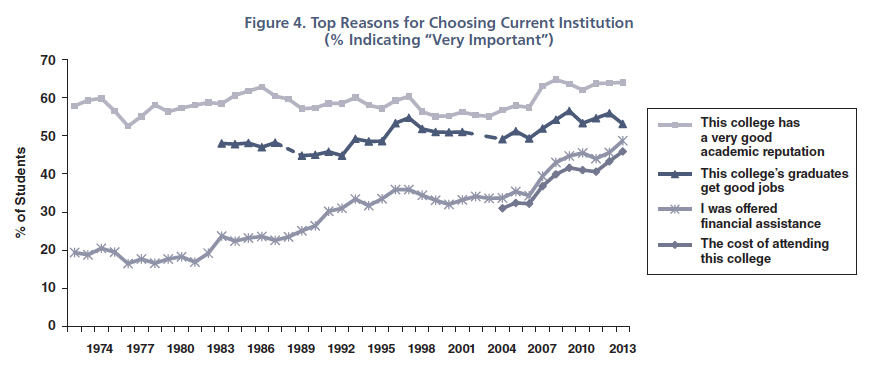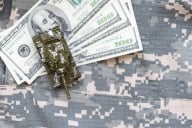You have /5 articles left.
Sign up for a free account or log in.
The 2013-14 academic year marks a half-decade since the economic recession hit, but concerns about the costs of attending college are influencing incoming freshmen more than ever, a new survey shows.
While more than three-quarters of this year's freshmen were admitted to their first-choice institution, an all-time low of 56.9 percent chose to attend it. Nearly 46 and 48 percent -- both all-time highs -- said price and financial aid, respectively, were "very important" in their decision about which institution to attend.
Online Ed Disconnect
The survey also finds that while most high school students use online education websites on their own time, very few see fully online courses in their higher education future. Read more.
Among students who were accepted but did not enroll at their first-choice institution, about a quarter said lack of financial aid from that college was a very important factor in their decision, and 60 percent said the same of being offered financial aid from the institution they chose to attend.
The record-setting numbers are not an anomaly. Last year's survey found that financial concerns increasingly affected students' decision-making in ways both educational (where to attend college and what to study) and personal (why to attend and whether to live on campus).
So it appears the impact of the 2008 economic recession has only gotten stronger from year to year.
"As state economies have recovered, we haven't really seen all of those dollars come back into higher education, and it's concerning that they may be gone for good," said Kevin Eagan, interim director of the Cooperative Institutional Research Program at the University of California at Los Angeles, which publishes the report annually. "Institutions cannot be too comfortable resting on their laurels and expecting that academic reputation will carry as much weight, or more weight, than any other factor in whether admitted students choose to enroll."
The annual survey is The American Freshman: National Norms. The report is usually released in January, but last fall's federal government shutdown delayed the results because the U.S. Education Department's Integrated Postsecondary Education Data System, on which CIRP relies for the report, was blocked for a time. The survey includes 165,743 first-time, full-time students entering 234 four-year American colleges and universities of varying selectivity and type.
While up-front price was not the most-cited reason why students chose the college they did -- those are still the institution's "very good" academic reputation (which 64 percent of students said was "very important"), and its graduates' job placement rates ("very important" to 53.1 percent of students) -- the importance of costs should outpace those other factors within five years or so if it keeps rising at the current rates, Eagan said.
The price tag was a particularly relevant issue for first-generation students: a 10.1-percentage point gap emerged between those students and continuing-generation students when asked whether an institution's cost was a "very important" factor in their enrollment (53.9 percent of first-generation students said it was).
And while the official report says more widespread use of the Common Application appears to be prompting students to apply to more institutions -- 55 percent of students in 2013 applied to more than four colleges, 10 percentage points more than in 2008 -- Eagan speculated that a desire to find the most affordable match may be playing a role here, too.
Leftward Tilt
This year's freshmen aren't just more price-sensitive than ever; they're increasingly liberal in many ways, too. The finding is consistent with the 2012 CIRP survey, which found that while the number of students who identified as liberal was actually declining, students were more liberal-leaning on an issue-by-issue basis.
In the months following the U.S. Supreme Court's striking down part of the Defense of Marriage Act, more than 83 percent of students -- women (86.8 percent) more so than men (79.2 percent) -- said they support the right of gay and lesbian couples to adopt children. And only about 40 percent of students said undocumented immigrants should be denied access to higher education. That figure is 15.6 percentage points lower than at its 1996 peak. The percentage of freshman support for raising taxes to reduce the federal deficit also peaked this year, at 36.9 percent, and 68.1 percent said wealthier people should pay more taxes.
However, in a year in which a school shooting occurred every two weeks, students reported less tolerance for gun control. Nearly 64 percent -- 20 percentage points less than 1989, when the figure hit its high -- said they support stronger gun control by the federal government. The opinions were predictable among students who identified as liberal or conservative, but nearly two-thirds of students who are "middle of the road" politically said the government should do more to control the sale of handguns.
This year, the researchers took a new look not just at where students are going, but where they came from, and found more racially diverse high schools and neighborhoods. Since 2006, the last time CIRP asked about the topic, the proportion of students coming from mostly or completely white high schools and neighborhoods, respectively, dropped from 64 to 53.5 percent and from 73.5 to 63.6 percent. Both figures have fallen substantially since their peak in 1983, the first time the survey asked the question.
However, students from white-dominated backgrounds reported being less open having their views challenged: Less than a quarter of students from predominantly white high schools said such openness is a "major strength," compared to about half of students at other schools.
"These different experiences and skills become evident in classrooms and interactions on college campuses," the report says, "requiring faculty and staff to be attentive to students' backgrounds and how they can move students from their own embedded worldviews."
| Business | 13 % |
| Medical doctor, surgeon, dentist or orthodontist | 11 % |
| Health care support | 9.2 % |
| Other | 4.9 % |
(Graph credits: Cooperative Institutional Research Program)









